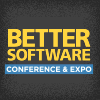Better Software Conference & EXPO 2009

PRESENTATIONS
|
Some Not-So-Crazy Ways to Do More with Less
When the world goes sideways, most people freeze, waiting for some clear signal of what to do. That's a really bad idea! Tim Lister suggests that within today's craziness are great opportunities to make big changes in everything-how you are organized, what you work on, how you set priorities, the whole shebang. Now is the best time to change the less than wonderful part of your organization’s culture. For instance, everyone has heard of Faster, Cheaper, Better. How about Slower, Cheaper, Better? |

Tim Lister, The Atlantic Systems Guild Inc |
|
Speaking 101
Are you a new Better Software speaker or aspiring to be one in the future? Join us at this workshop on making effective conference presentations. Learn the secrets of developing content, identifying the Big Message, preparing slides with just the right words and images, presenting your message, handling questions from the audience, and being ready when things go wrong. Lee Copeland, a professional speaker since birth, shares ideas that will help you become a better speaker, no matter what the occasion. |

Lee Copeland, Software Quality Engineering |
|
Successful Software Management: Seventeen Lessons Learned
Wouldn't it be nice to know what your staff is doing without looking like a micromanager? Have you wondered how to treat people fairly while still giving them what they need? Would you like to spend a week out of the office, but you're worried your staff won't be able to manage while you're gone? Johanna Rothman explores questions that face software managers every day. Gain new insights through the mistakes she made and the lessons she learned after she became a manager and then a consultant after years of hard-core technical work. |

Johanna Rothman, Rothman Consulting Group, Inc. |
|
Successful Teams are TDD Teams
Test-Driven Development (TDD) is the practice of writing a test before writing code that implements the tested behavior, thus finding defects earlier. Rob Myers explains the two basic types of TDD: the original unit-level approach used mostly by developers, and the agile-inspired Acceptance-Test Driven Development (ATDD) which involves the entire team. |

Rob Myers, Agile Institute |
|
Table-Driven Requirements with the FIT Testing Tool
Eliciting and articulating customer requirements-clearly and precisely-is difficult to say the least. Inaccuracies often creep in when translating requirements from business ideas into software models. Working with many clients, Alan Shalloway found that creating a large number of tables with examples-however time consuming the tables are to create-adds to the clarity and precision of requirements. He found, too, that if you can use the same example table as tests, then the time is well spent. |

Ken Pugh, Net Objectives |
|
Ten Practices of High-Performance Teams
With all the hype about agile, lean, CMMI®, and every other method du jour, we sometimes forget that our real goal is high performance. High-performance software teams consistently deliver products that delight their customers, all while remaining on schedule, keeping with agreed-to functionality, and maintaining high quality. These teams are proud of what they produce and are continuously improving the way they work. Over the past decade, Noopur Davis has worked with many high-performance teams in both large and small organizations. |

Noopur Davis, Davis Systems |
|
Testing in Turbulent Projects
Turbulent weather such as tornados is characterized by chaotic, random, and often surprising and powerful pattern changes. Similarly, turbulent software projects are characterized by chaotic, seemingly random project changes that happen unexpectedly and with force. Dealing with turbulence is about dealing with change. Testing teams must contend with continuously changing project requirements, design, team members, business goals, technologies, and organizational structures. |

Robert Sabourin, AmiBug.com Inc |
|
The Agile PMP: Teaching and Old Dog New Tricks
Agile methods emphasize trust, empowerment, and collaboration-moving us away from command and control project management to harness the passion, creativity, and enthusiasm of the team. In established organizations, success with agile practices hinges on how well traditional project managers adopt new ways of thinking about project structure and control. |
|
|
The Dirty Little Secret of Business
Regardless of your role in the software lifecycle, there are challenges and roadblocks that stand in your way. How can you deal with difficult people who are obstacles to your ability to deliver? How can you influence someone to act on your priorities even when you don't have the organizational authority? How can you find time to network when you're overwhelmed with day-to-day work? Andy Kaufman shares "The Dirty Little Secret of Business." You won't learn this secret in school, yet it is critical to your success. |

Andy Kaufman, Institute for Leadership Excellence and Development |
|
The Many Styles of Pair Programming
Joining an agile team can be very challenging-new programming styles, new coding standards, new check-in requirements, new leadership styles, and more. Adding pair programming to the mix can be "the straw that broke the camel's back" or it can be key to team empowerment. Paul Julius has been a dedicated pair programmer since 1999, working on many projects with 100 percent pairing. Paul has distilled a set of positive and negative patterns that can develop when teams attempt pair programming. |
|


